 |
Fans of the
Paris Printemps Grands Magasins (and the Oiseau Bleu)
 |
Fans of the
Paris Printemps Grands Magasins (and the Oiseau Bleu)
Beware: reproduction of all or part of the texts or photos on this site, for any purpose and in any form whatsoever, is prohibited without our consent.
Some fans are very expensive, even if their price is not commensurate with that of certain contemporary works (of art?). But, and this is good news for collectors and enthusiasts, many fans worth only a few dozzens of Euros (or even a few Euros, dollars or pounds!). They may be of great interest, though. This is rarely the case with fans for tourists from the 20th or 21st centuries. But advertising fans offer the curious and the scholar significant resources. Among them, many concern the Parisian department stores (for a history of these, we can have a look at an article (in French) by Claudine Chevrel). The concept was born gradually from the end of the 18th century, but received a decisive impetus when in 1852 Aristide and Marguerite Boucicaut joined forces with brothers Paul and Justin Videau to develop the Au Bon Marché store, rue de Sèvres and rue du Bac. The oldest fan that we have in this category, and that we will perhaps show one day, follows shortly: it dates from 1856 and shows, as a "Souvenir of the April 1856 Exhibition" a "View of the new commercial galleries", populated by ladies in crinolines and eager salesmen. Other fans advertising these "supermarkets" of the time also date from the Second Empire. We show one in our page dedicated to "Le Monstre et le Magicien" (a Frankenstein fan). This fan, while being an announcement of the eponymous play and a calendar for the second half of 1861, is indeed also an advertisement for the Aux Bains Turcs store, quickly supplanted by its new competitors like the Bon Marché. We must quote also the other Grands Magasins: Le Louvre (1855), La Belle Jardinière (1856), les Grands Magasins du Printemps (1865), La Samaritaine (1865) or, later, les Galeries Lafayette (1896). Almost all of these houses have used advertising fans. We often meet on the market those for Galeries Lafayette, some decorated by Gabriel Domergue (like the one we show here) or those of Le Louvre. Examples of all these fans can be found quite easily in the works devoted to advertising fans or on the websites of Parisian museums such as Galliera or the Paris Musée des Arts Décoratifs.
We shall study here those for Le Printemps, although (or because) they are modest. This modesty means that we easily miss them, or that by seeing one, we think: "this one, I have already seen it". This same impression - sometimes misleading - is found in other periods, as we have shown for example with the fans of the Loterie de l'Amour (see our article "Amour, loterie et fans, Le Vieux Papier, F. 427, January 2018, p. 409-415). It is only the careful examination of each object that makes possible to note the sometimes subtle differences, with the satisfaction of bringing us to question ourselves; and here as elsewhere, the questions often matter as much as the answers.
First, let's say a word about the relationship between Mr. Jaluzot, the Printemps owner, and fans. Indeed, he had obtained from Gustave Eiffel the exclusive authorization to reproduce the tower in miniatures, with the metal scraps of the construction, and had subcontracted with many industrialists or craftsmen: jewelers, glassmakers, bronziers ... and fan makers. Alas in April 1889 a Paris Tribunal decided that the property of the Tower being acquired by the State, it was the same for reproduction rights. This encouraged the appearance of a large number of souvenir objects from the exhibition, including many fans that we know of.
The forced leisure offerd by the Covid 19 epidemic allowed us, in a general proofing of our fans, to note that we had, without having really noticed it, twelve fans advertising the Grands Magasins du Printemps, with - apparently - duplicates to possibly sell or give away... which we haven so far only managed to do on the occasion of the gatherings of the Fan Circle International, the Fan Association of North America or the Cercle de l'Eventail. Here is a succinct table of these fans, each beeing given a number, with the height of the fans -in centimeters- (H), the number of the sticks (add two for the guards or outer sticks), the nature of the decoration, the material of the monture and a distinctive type. Please note that all these fans are folded, only one being a "cockade".
n° H brins décor monture type 1 19,5 21 bandes tricolores bambou à l'anglaise 2 20,5 16 bandes tricolores panaches bleu/rouge à l'anglaise 4 20,5 16 bandes tricolores panaches bleu/rouge à l'anglaise 3 20,5 16 bandes tricolores panaches bleu/rouge à l'anglaise 5 27,5 8 bandes tricolores panaches bleu/rouge double 6 27,5 8 bandes tricolores panaches bleu/rouge double 7 33,8 2 fleur très stylisée bois ordinaire éventail cocarde 10 15,3 3 fleurs bois ordinaire à l'anglaise 8 15,3 3 fleurs bois ordinaire à l'anglaise 9 27,1 3 fleurs bois ordinaire marron double, asymétrique 11 27,9 8 fleurs, fond jaune bois ordinaire double 12 27,3 8 grande fleur, fond jaune/vert bois, panaches foncés, brins clairs double
As you can see, half of these fans are with "bandes tricolores" (blue, white and red stripes), and the other half are decorated with flowers. We also see, just by reading this table that within the same category there are notable differences (height, number of sticks, "à l'anglaise" or double-leaf mounting, nature of the monture). We will first look at these fans with tricolor stripes.
I - FANS WITH TRICOLOR STRIPES
A quick search (and therefore perhaps incomplete) does not allow us to find these tricolor bands systematically on other advertising objects of the company. Their meaning seems obvious. For the French public, in the period marked by the succession of the wars of 1870, 1914-1918 and 1939-1945, it is obviously a question of adherence to a widely shared patriotic sentiment. For the foreign public (whose clientele has always been important for the Parisian department stores) this makes it easy to accentuate the souvenir character of these fans.
The table above makes it possible to distinguish three types in this category. It is important to say that all bear the essential slogan: "Every elegant woman is a client of the Printemps".
A - 19,5 cm, mounted à l'anglaise, 21 sticks and natural bamboo monture, with the inscription "V. Espi, Paris" (fan n° 1 in the above table)
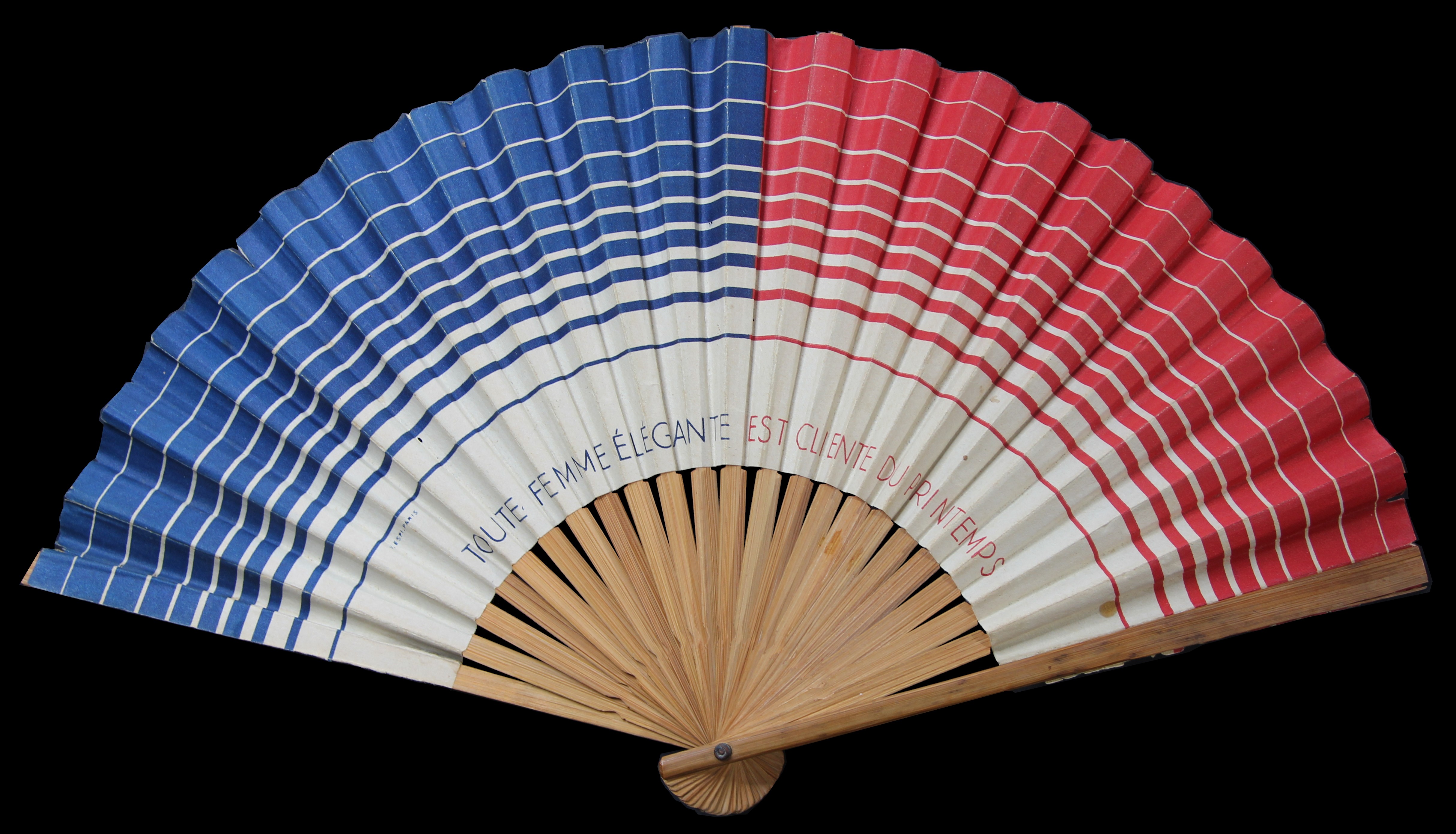
B - 20,5 cm, mounted à l'anglaise, 16 sticks, one red guard, another blue, with the inscription "V. Espi Paris" (fans n°s 2, 3, 4). The workmanship is obviously more careful here than in the previous model: coloured guards, well marked folds, regular gap between the stricks, all qualities that the model "A" lacks. We give here a picture of the fan n ° 4. The n ° 2 is identical.
Fan n° 3 is quite similar to n°s 2 and 4. It will however lead us to a rather long digression, which justifies the Oiseau Bleu (Blue Bird) which appears in the title of this page. We hope we are not boring you, dear reader: if so, please scroll down! This allows us to talk about fans with handwritten mentions. There are, of course, annotations written by the donor of the fan, or recalling his name, small fans (one of Lachelin's specialties), fans making a guestbook, with signatures of known or unknown people, who sometimes adorn their inscriptions with drawings, musical staves or verses (think of Mallarmé!). We also have a fan where an actress (non-professional, no doubt) had written all her lines on the reverse. Here, the reverse is entirely covered with handwritten writings giving us on the far left a date: "June 30, 1939" and on the far right what the event is: "Evening for the benefit of the Oiseau Bleu". Across the fan leaf, between the words "Program" and "End" appear the names of the many parts of the show, and their performers. Many of these, mostly forgotten now, were well known at the time, or during the decades that followed. We reproduce this verso of the fan, with below the program some brief mentions about the artists that we have been able to identify.
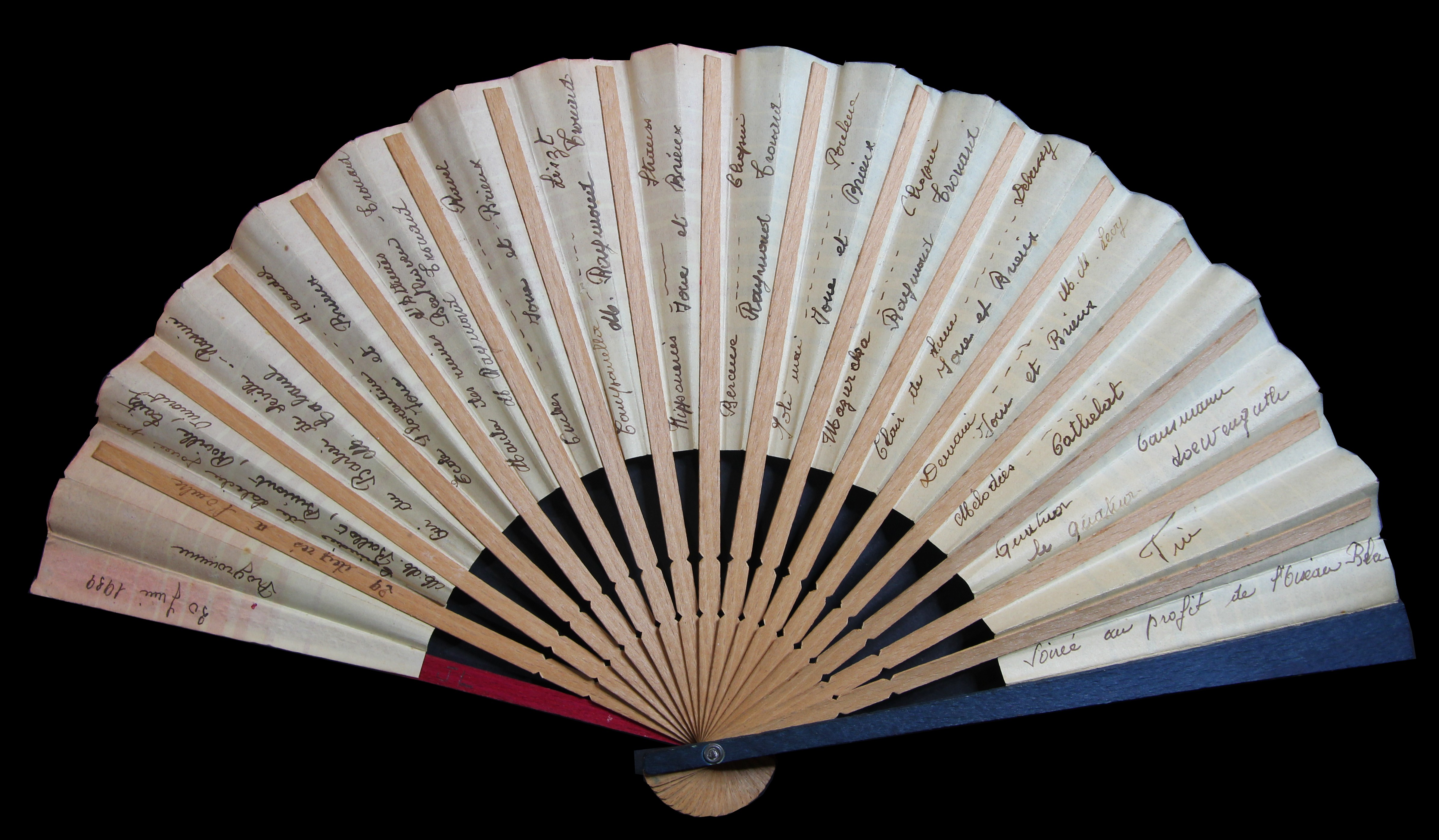
Titre Auteur Interprètes 29 degrés à l'ombre Labiche MM Ballot, Buirout, Roville, Taitz, Vimont Air du Barbier de Séville Rossini M. Cabanel Ecole Florentine Haendel Ione et Brieux Marche des ruines d'Athènes Beethoven - Trouard M. Raymond Trouard ??? Ravel Ione et Brieux Campanella Liszt M. Raymond Trouard ??? Strauss Ione et Brieuxx Berceuse Chopin Raymond Trouard Joli mai Poulenc Ione et Brieux Mazurcka Chopin Raymond Trouard Clair de Lune Debussy Ione et Brieux Demain M.M. Levy Ione et Brieux Mélodies - Cathelat Quatuor Gausmann (?) Quatuor Loewenguth
This verso gives us an important information: it is that these fans were released before June 1939, unless we imagine that some pervert took the trouble, years later, to copy the program of an charity evening on a more recent fan. However, the particular design of these fans, sober or even simplistic, does not facilitate dating. Moreover, an identical fan is said by the Paris Musée des Arts Décoratifs "circa 1950" (inv. 2011.80.87). We do not think that the maker of the fan (V. Espi) was still active in 1950.
To continue the announced digression, we will give (in French) some information about some artists who took part in this charity event.
CABANEL Jean Paul dit Paul. — Basse (Oran 1891 – Paris 1958). Débute le 18 janvier 1932 dans la Tosca (Scarpia). Chante Carmen (Escamillo), le Barbier de Séville (Bazile), Louise (le Père), Manon (le Comte Des Grieux), Mignon (Lothario), Nele Dooryn (Père Fredaels), les Noces de Figaro (Figaro), Paillasse (Tonio), Lakmé (Nilakantha), la Bohème (Colline) et les Contes d’Hoffmann (Lindorf, etc.). Il tint une classe d'opéra au Conservatoire de Paris de 1942 à 1958.
CATHELAT Georges, ténor français (Paris 1904-1993). Nombreuses distinctions au Conservatoire de Paris entre 1927 et 1931. Interprète dès 1930 à la radio Paris-PTT dans la cavatine de Faust puis se produit à l'Opéra-Comique, au Théâtre des Champs-Elysées, mis aussi en 1938 dans Pelléas et Mélisande à l'Opéra de San Francisco, puis en 1940 au Metropolitan Opera de New York le 7 mars 1940, avant de revenir à Paris, en particulier à l'Opéra-Comique. Il fut aussi acteur de cinéma, débutant en 1933 dans un film... muet !
IONE et BRIEUX - Yves Brieux-Ustaritz (1905-1991). Danseur et pédagogue français, il quitta l'Opéra de Paris au début des années 1930 pour se produire en gala à travers l'Europe avec sa partenaire Geneviève Ione, qu'il aurait épousée. Après 1940, il se consacra à l'enseignement, en particulier à l'Opéra de Paris.
TROUARD Raymond, pianiste français (1916-2008). Premier prix de piano en 1933 au Conservatoire, où il a enseigné entre 1969 et 1985, prix Louis-Diémer en 1939, ce virtuose ayant impressionné ses contemporains par sa technique a laissé de solides interprétations de la Sonate de Liszt et des Valses de Chopin. Mais son répertoire a été beaucoup plus large, au récital comme en concert des deux côtés de l'Atlantique.
On peut aisément écouter Raymond Trouard, et même le voir.
Le quatuor LOEWENGUTH était un quatuor à cordes français fondé en 1929 par Alfred Loewenguth, qui en fut le premier violon pendant toute son existence (jusqu'en 1983). Ce quatuor à cordes a eu une renommée internationale et a gravé de nombreux disques, de Bach à Milhaud, avec une insistance particulière sur Haydn, Mozart, Beethoven et la musique française. Il a obtenu un Grand Prix du disque.
But for what audience, and for what reason did these artists gather on June 30, 1939? In other words, what is this "Oiseau Bleu"? Over time, we find under this name many different objects, from an innovative educational magazine to an association of sick children, passing by a poem by Maeterlink and even a semi-secret military operation during the Algerian war. The only answer that seems both plausible and reasonable is that this is an property located in Boissy l'Aillerie (north of Paris). This property, acquired by the Unions Chrétiennes de Jeunes Filles with the help of their counterparts in the United States, played a large role in the creation of French scouting (especially in its feminine and Protestant branch), before becoming a holiday home and a rest place of the U. C. J. F. intended in particular for young workers or employees. The property is now used to aid in the detoxification of young drug addicts.
Une salle de l'Oiseau Bleu à Boissy-L'AillerieAfter this digression less futile than it seems, since it allows us to think of an often forgotten use of fans, let's come back to our study of the fans of Le Printemps! In the family of fans with tricolor stripes, there is in fact one category left to study.
C - 27,5 cm, double leaf, 8 sticks, sticks and one of the guards tinted in red, the other guard in blue, with the inscription "V. Espi Paris" (fans # 5 et 6). These fans are characterized, in addition to an uncommon height for advertising fans of the 20th century, by a very small span, also quite squarce. Another peculiarity that we do not remember having noticed elsewhere, the sticks ands and a guard in one color, and the second guard in a different one. The double leaves are identical on both sides, however the colors are inverted. In addition, due to the asymmetric coloring of the frame, the aspect differs depending on the side of the fan viewed, as shown below in the photos of fans 5 and 6. For the Galliera museum, this fan dates from the 2nd quarter of the 20th century (Inv. 1985.145.1). This dating does indeed seem plausible. In this category, Michèle Verdier, an excellent fans collector, especially of advertising fans, tells us about an "alien". This fan respects almost completely the codes of our fans 5 and 6, BUT, according to an inscription on the leaf, was made by J. Ganné, and, very surprisingly, the blue is replaced by a dark black. We do not imagine a voluntary action of an anarchist typographer, and think it is the consequence of some error ... which may have deprived Ganné of this command. Michelle Verdier allows us to reproduce photos of this fan below, and we thank her very much.
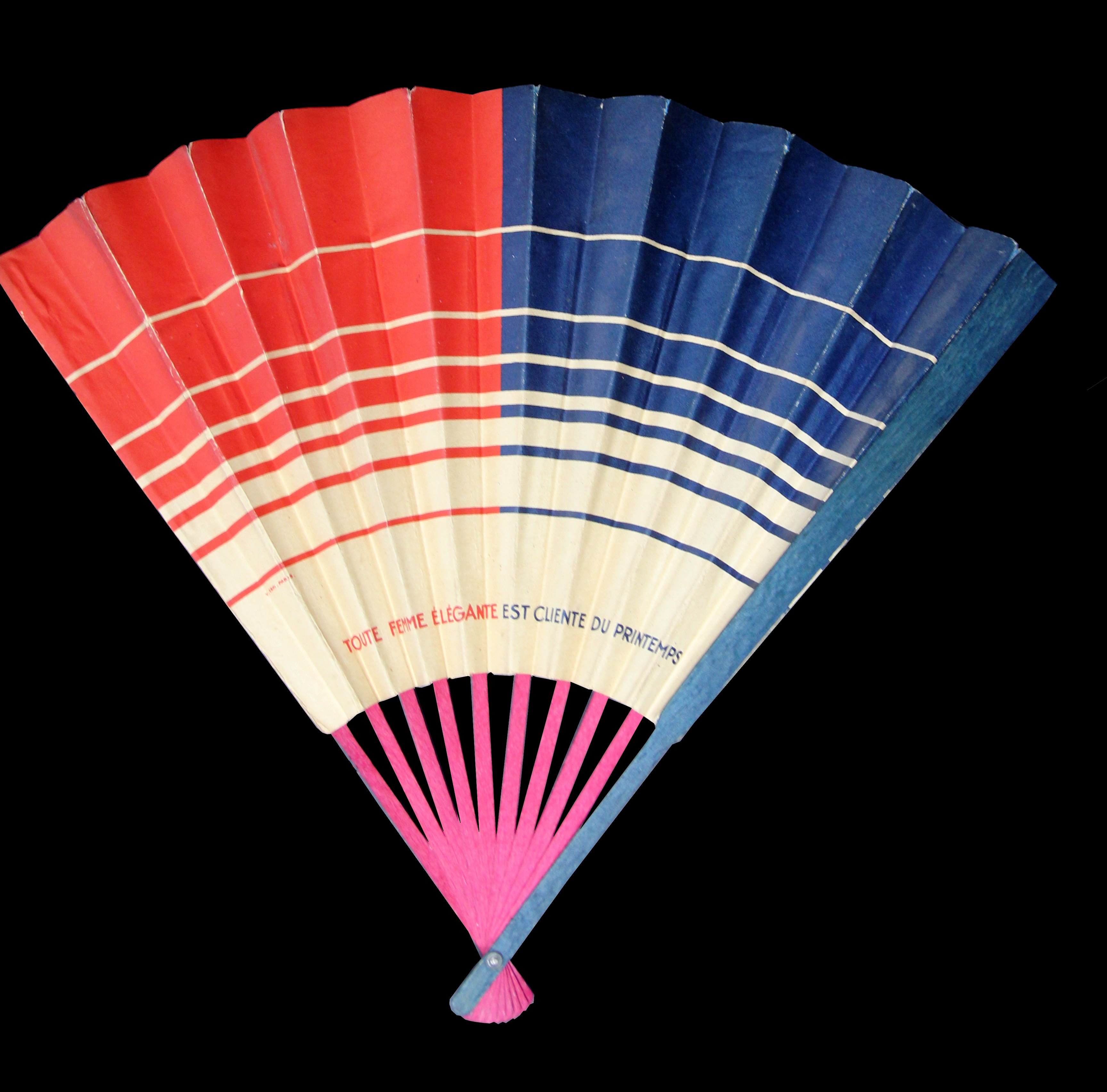
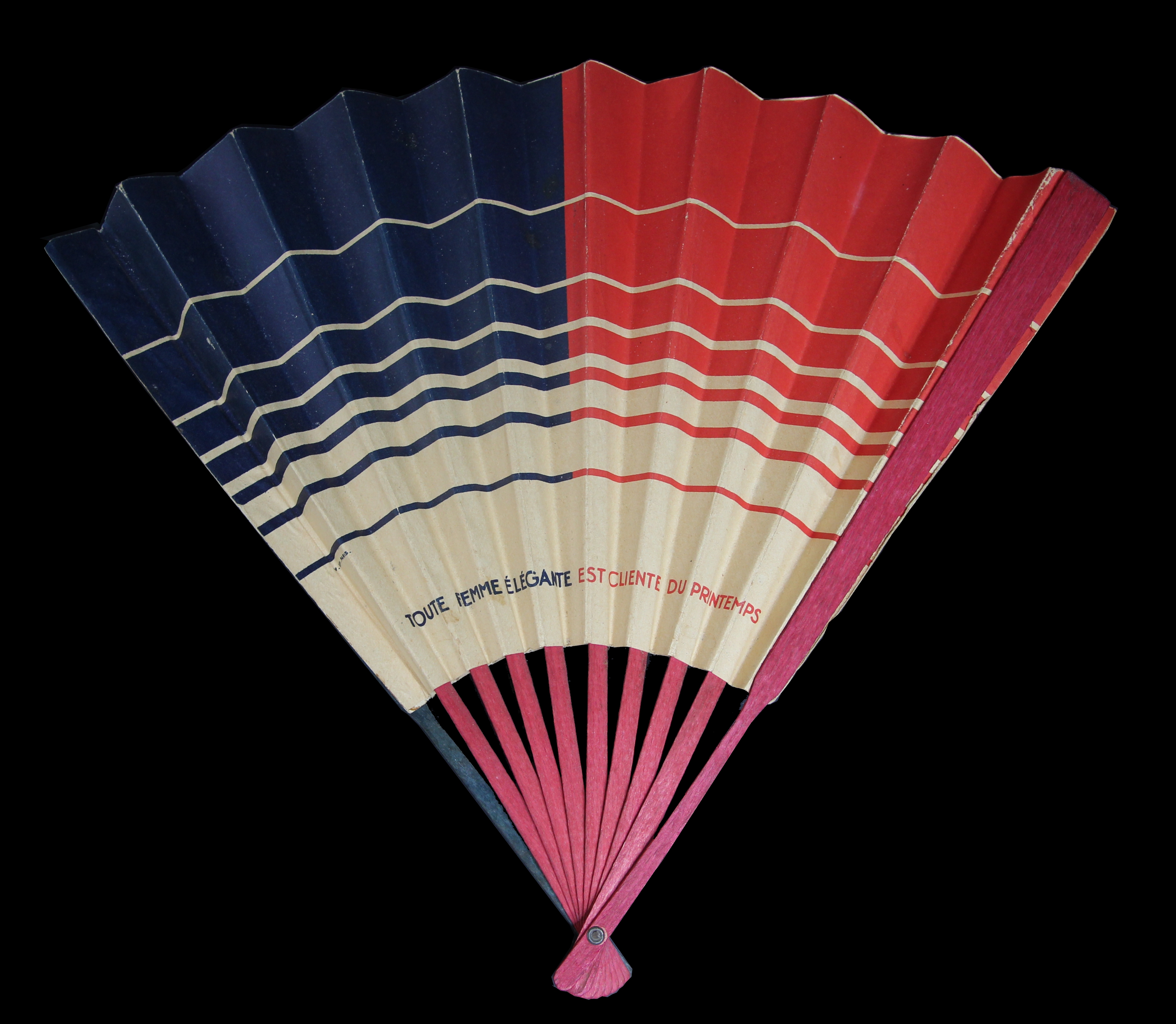
II - FANS WITH FLOWERS
This family will turn out to be much less homogeneous than the "tricolor stripes" family, especially since it will include, as we will see, "fraternal twins". We will examine them - this criterion is worth another! - by decreasing size of the open fan.
A - Cockade or "Vent du Nord" fans (n° 7 of the above table). We have had on several occasions the opportunity to mention these fans, in particular on our page "Vents du Nord". All those for the Printemps bear the mention "Chambrelent Eventailliste Paris". This was the great specialty of this important house, as evidenced by the illustration we show below. We notice, at the top center, the fan we are talking about. The fact that Chambrelent thus put this fan produced for the Printemps Stores in the foreground is undoubtedly a sign of the quality of the business relations between the two companies. These cockade fans exist with various decorations. There are a number of them, for example on the website of the Paris Musée des Arts Décoratifs. It should be noted that those which are considered to be the oldest (1910s) only bear a discreet mention "Au Printemps" (see for example the one referenced 2011.80.33) and not the emblematic sentence "Any elegant woman is a client of the Printemps". Our friend Michèle Verdier also offers a picture of one of these fans, that we reproduce below.
The recurring phrase would not appear on the "vent du nord" fans until the 1920s. It is therefore at this time that the fan shown here would have been edited.
Our kind correspondent also points out another cockade fan of a special type. It has the advantage of being buit with a folding system in four elements connected by axes : when unnfolded they constitute the handle of the screen, and when folded they enclose the leaf in a protective small box. This system is illustrated in a French patent (n° 1306746 (9/09/1961) by Maurice Zriem: cf Maryse Volet, Les brevets d'éventails déposés en France au 20ème siècle, Vésenaz, 1992, p.210-211.These fans (as far as we know always made in Hong Kong) were originally made of metal, like the one we see here, but they are also found in plastic. One of the most noticed is presented in a carboard box marked "Keep cool and be gay". At this time this adjective had little of the particular connotation it now has.
The fan Michèle Verdier shows us, in addition to the "made in Hong Kong", has on the handle the stamped mention "Midget Fan N° 104" and above all has on the leaf the inscription "Au Printemps - Le magasin le plus élégant de Paris". However, we have never seen this sentence on any other advertising medium. Some posters do include this sentence, but in the plural, as we can see below (BnF, ENTOA-1-GRANDROUL). Work of a counterfeiter ???
B - In this category we group the fans n°s 11 and 12 of our introducting table. Those large fans were made by J. Ganné and have a narrow span. The fan n° 11 has a yellow background, and n ° 12 a yellow / pale green background. The first (below on the left) presents, on a natural wooden frame, a double leaf showing on a yellow background a throw of very stylized flowers (tulips?) in limited colors (pale gray and red). Recto and verso are identical, and both include near the gorge, the magic formula: "Every elegant woman is a client of the Printemps" and, on the left side, the mention "J. Ganné - Paris". An identical fan appears in the collections of the Palais Galliera under number 1984.120.48. The museum dates this item back to the 1930s or 1940s, which seems very likely.
The second (# 12, right below), has an ordinary wooden frame, the guards being darker than the sticks. The leaf is adorned with only one very stylized flower. This flower is of the same nature as those seen on fan n° 11, but huge and colorful like a rainbow. The mention "Every elegant woman etc." also appears near the gorge. The verso (only) bears the mention "J. Ganné - Paris". An identical fan appears in the collections of the Palais Galliera under n° 1984.120.5, like the previous one presumed to date from the years 1930-1940. The description given seems excellent, and deserves to be copied: "The surface of the leaf is divided into 2 parts of equal area on the left, yellow on the right, in the center, a tulip symbolizing spring is also divided into 2 parts : on the left vertical bands red, white, green, white, blue, white, red and on the right entirely white, at the bottom of the stem, 2 leaves schematized in black and white, one with veins".
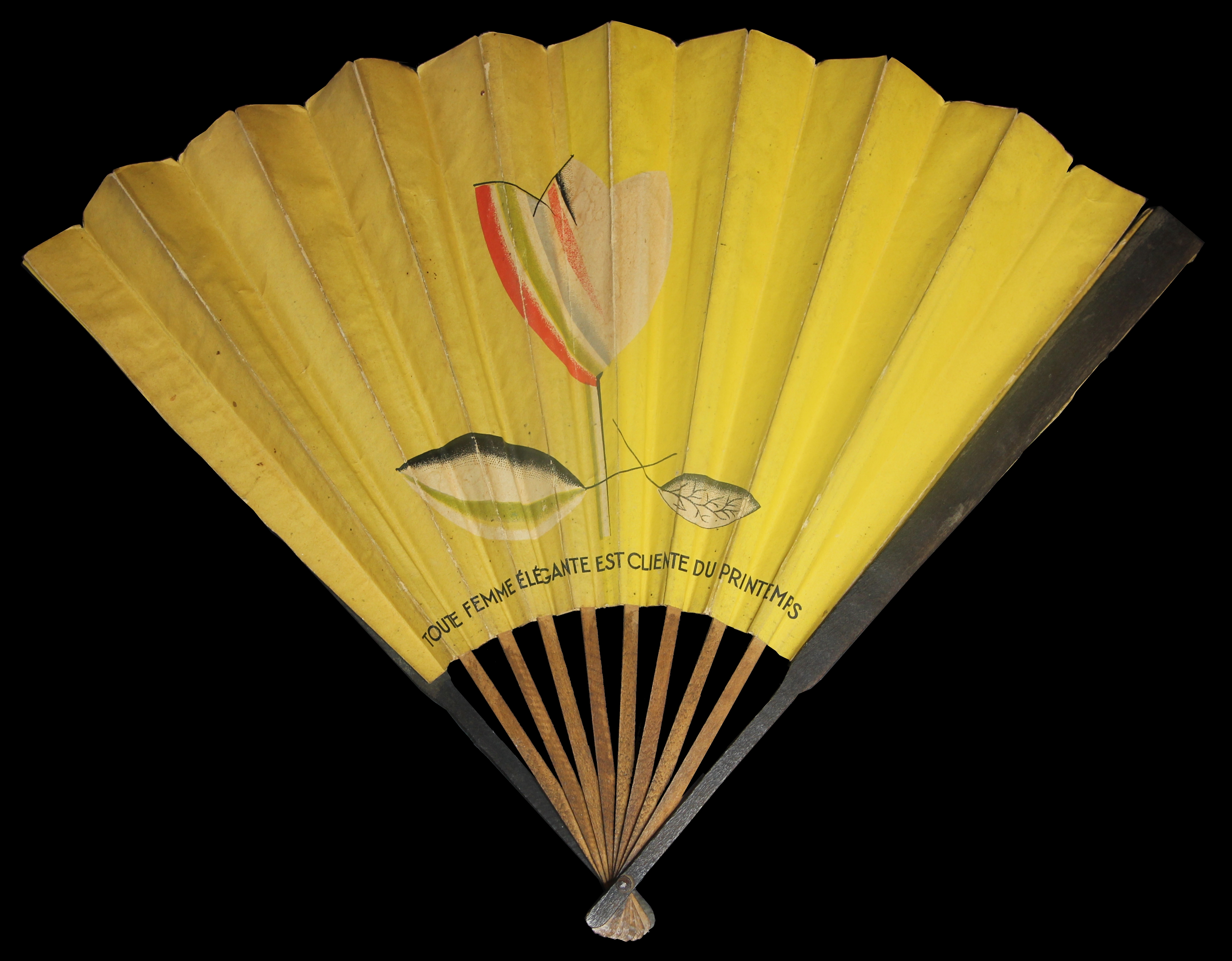
C - Another category of this family of Printemps fans with flowers, is represented in our table by a single copy : it is n° 9.
This one has the remarkable feature of being asymmetrical. Its leaf is double, but the reverse is mute. The recto is adorned by a splendid bouquet of various blooming flowers
This fan, which contrasts with the simplicity of the other "Printemps" fans, seems much rarer than the other models. Apparently, it does not appear in the collections of the Parisian museums that we mention elsewhere.
However, it is sometimes found in public auction sales, and it appears in specialized publications devoted to advertising fans. Magdeleine Ducamp (La Folie des Eventails, Flammarion, 2001) shows this (p. 189), dating it from the 1930s and specifying: "Always the same slogan on this fan in the form of a "bird wing ", which has surely inspired the famous model for Dior stockings".
D - Small fans with floral borders. In this family of Printemps fans with flowers, (and what could be more normal than flowers, as "printemps" means "spring"?), we still have to study those which in our initial table bear the numbers 8 and 10. In a simplistic description, they seem identical: same measurement, same number of sticks (3 + 2), same "à l'anglaise" mount, both with flowers (different, but comparable) around the edge. A priori, the main differences lie in the fact that fan n°10 is monogrammed C.G. and in the typography of the "slogan", which for n° 8 is in script, and for n° 10 in italics. Are there not any other difference? Many auctioneers, or museum employees do not see it, and that is quite normal: why take a close interest in these modest objects, which are worth a few (small) dozzens of Pounds or Dollars, if not less? And you ? What do you notice when you look at them, displayed below side by side (n° 8 on the left, n° 10 on the right)?
Now then? Do you see this fundamental difference?
It must be recognized that many people do not see it! In Fans, Advertising and Souvenir (Schiffer, 2012), an essential work in this field (despite overly optimistic estimates), Donald Bull and Rodolphe Roger juxtapose (p. 121) these two versions of the same theme, with a single translation "Any elegant woman is a client of the Printemps". And Galliera (the real name -Musée de la Mode et du Costume de Paris- is longer!), on describing an object identical to our fan n° 10, (above right), reads: "Every elegant woman is a client at the Printemps" (1986.224.4).
No doubt you now see, if you had not already noticed it, the essential difference between these two models. Yes: the fan on the right (n° 10) uses the ritual formula "Every elegant woman is a client du (of the) Printemps" while the fan on the left (n° 8) is distinguished by a word: "Every elegant woman is a client au (at the) Printemps". The graphic difference is minor, and the difference in meaning minimal. Admit that it is not surprising if some people are lead into a mistake. Besides, the same Musée Galliera, in describing one of the cockade fans that we analyzed above, sees the sentence "Every elegant woman is a client au (at the) Printemps". But even when we widen our eyes we still see a "du", not an "au". (Inv. 1986.269.5). The museum also sees an "au" and not a "du" on one of the large fans with a yellow background (n ° 11 above, cf. 1984.120.48). The most surprising thing is that if the advertising slogan is found with "cliente du Printemps" on a number of media, from posters to paper bags, including ashtrays (see opposite), it is only on these small fans that we notice the formula "au Printemps". We are for the moment quite unable to explain this, except by the error of a typographer, pushed perhaps to the fault by a customer order with a sloppy writing... Many readers will see in our remarks an exaggerated attachment to trifles,or -let us dare the word-, a "nitpicking". Let's face it, they are wrong. In matters of fans of all origins, of all periods and of all monetary values, this attachment to "small differences" is a source of knowledge and cultural enrichment. We showed it a long time ago with our cigarette fans. This attention to detail has often been useful to us, for example in studying the "French leaves, Spanish fans", or more recently in describing a fan dealing with the (small) Parisian history ("Les omnibus-gondoles, un projet tombé à l'eau... et caricaturé pr Cham... (sur un éventail ?) ", Le Vieux Papier, n ° 458, October 2020, p. 354-360). Here comes the end of this too long article, on a so minor subject. And yet, we haven't exhausted it. There are other Printemps fans, such as a small fan that you don't see often, printed in black on a red background and showing a radiant view of the Printemps stores and the crowds flocking there (Bull et Roger, op. cit. p.122). If our kind readers want to point out others to us - or to correct our mistakes - it will be with pleasure that we will stretch it out even further! But we wouldn't want to let you go without this sight of a last Printemps fan, which shows the magnificent glass roof of the Parisian store. It was edited by Duvelleroy (ie the late Michel Maignan) and his accomplice Lucie Saboudjian in 1990, to celebrate the establishment's 125th anniversary. May it serve us to salute the memory of the first, and to wish the second many sunny springs.
Reminder: reproduction of all or part of the texts or photos on this site, for any purpose and in any form whatsoever, is prohibited without our consent.
N'hésitez pas à me faire part de vos commentaires, remarques, critiques... et à prendre contact avec moi à tout propos se rapportant aux éventails, notamment en lien avec ma recherche principale, qui porte toujours sur les sujets des éventails européens de la fin du XVIIe au début du XIXe siècle. Merci !